
The Gyeongbu line (Gyeongbuseon) is a railway line in South Korea and is considered to be the most important and one of the oldest in the country. It was constructed in 1905, connecting Seoul with Busan via Suwon, Daejeon, and Daegu. It is by far the most heavily travelled rail line in South Korea.
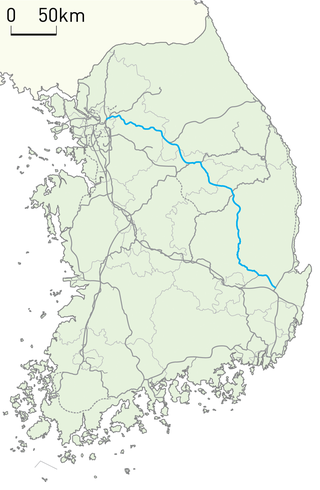
The Jungang line is a railway line connecting Cheongnyangni in Seoul to Moryang in Gyeongju in South Korea, traversing central South Korea from the northwest to the southeast. It is also referred to as the rail line of the Seoul Metropolitan Subway from Yongsan station to Jipyeong station. The section from Cheongnyangni to Dodam was designated as a semi-high-speed railway.
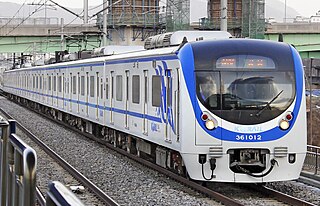
The Gyeongchun Line is a regional rail line between Seoul and Chuncheon, South Korea, operated by Korail. Its name is derived from Gyeong and Chuncheon. It was completely reconstructed in the 2000s. Service on it has operated between Sangbong station on the Jungang Line in eastern Seoul and Chuncheon station, as part of the Seoul Metropolitan Subway system, since December 21, 2010. A class of regional rail service named ITX-Cheongchun began operations on February 28, 2012, linking Chuncheon to Cheongnyangni and Yongsan Stations.

The Gyeongui Line is a railway line between Seoul Station and Dorasan Station in Paju. Korail operates the Seoul Metropolitan Subway service between Seoul Station and Dorasan Station.
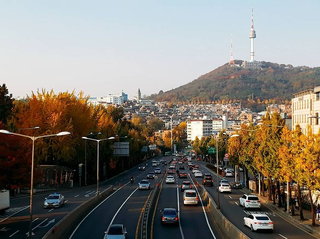
Yongsan District is one of the 25 districts of Seoul, South Korea.

Seoul Subway Line 2, also known as the Circle Line, is a circular line of the Seoul Metropolitan Subway. The line running clockwise is called the "inner circle line" and the counter-clockwise line is called the "outer circle line". This is Seoul's most heavily used line, and consists of the main loop, the Seongsu Branch and the Sinjeong Branch for a total line length of 60.2 km (37.4 mi). The Line 2 loop is the third longest subway loop in the world after Moscow Metro Bolshaya Koltsevaya line and Beijing Subway Line 10. In 2019, Line 2 had an annual ridership of 812 million passengers or 2.2 million passengers per day.

Seoul Subway Line 9, operated by Seoul Line9 Operation, is a subway line in Seoul, part of the Seoul Metropolitan Subway. The line runs east from Gaehwa station or Gimpo International Airport station along the south bank of the Han River towards VHS Medical Center in Gangdong. In 2019, Line 9 had an annual ridership of 225 million or about 616,000 people per day.

Gwanghwamun Station (Korean: 광화문역) is a station on the Seoul Subway Line 5 in South Korea. It is not the closest subway station to the actual gate of Gwanghwamun, which it is named after. It is located next to the U.S. Embassy in Seoul.
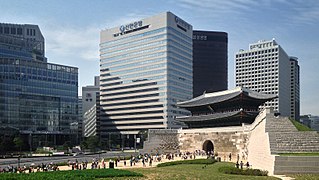
Jung District is one of the 25 districts of Seoul, South Korea.
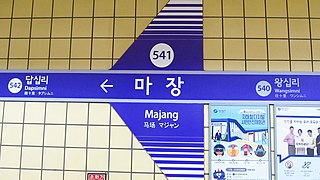
Majang Station is a station on Seoul Subway Line 5 in Seongdong-gu, Seoul.

Dapsimni Station is a station on the Seoul Subway Line 5 in Dongdaemun-gu, Seoul.

Achasan, also known as Rear Entrance to Seoul Children's Grand Park, is a subway station on Line 5 of the Seoul Metropolitan Subway. Located in Gwangjin-gu, in Seoul, South Korea the station is near the rear entrance of Seoul Children's Grand Park.
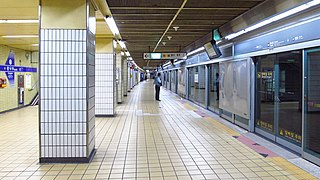
Gwangnaru Station is a station on the Seoul Subway Line 5 in Gwangjin-gu, Seoul. Its station subname is Presbyterian Univ. & Theological Seminary, where said university is nearby Exit 2.

Cheonho station is a subway station on the Seoul Subway Line 5 and Line 8. Its station subname is Pungnaptoseong, referring to the Pungnaptoseong that runs between this station and the southeastern end of the Olympic Bridge.

Gil-dong Station is a subway station on Seoul Subway Line 5 in Gangdong-gu, Seoul. There is a connecting track from this station to Dunchon-dong Station on the Macheonji Line of Line 5, but it is a return train track for the arrival and departure of the Godeok Vehicle Business Office and has nothing to do with passenger operations.
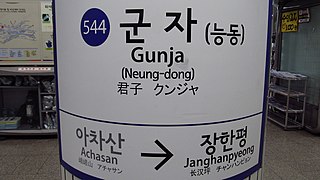
Gunja (Neung-dong) Station (Korean: 군자역) is a station on Line 5 and Line 7 of the Seoul Subway in Gwangjin-gu, Seoul.
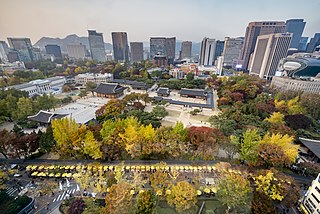
Seoul, officially Seoul Special City, is the capital and largest city of South Korea. The broader Seoul Capital Area, encompassing Gyeonggi province and Incheon metropolitan city, emerged as the world's fourth largest metropolitan economy in 2014, trailing only Tokyo, New York City, and Los Angeles, hosting more than half of South Korea's population. Although Seoul's population peaked at slightly over 10 million, it has gradually decreased since 2014, standing at approximately 9.97 million residents as of 2020. Seoul is the seat of the South Korean government.

Gubeundari Station is a subway station on Seoul Subway Line 5 in Gangdong-gu, Seoul.

The Seohae Line is a dual-track, electrified rail line in western Gyeonggi-do and Seoul, South Korea. The Seohae Line is being built in four sections simultaneously. The line runs 47 km (29 mi) south from Ilsan in Goyang City, crosses the Han River, passes Gimpo Airport, Sosa, Siheung, and ends in Wonsi in Ansan. There is a transfer to different lines at Daegok, Neunggok, Gimpo Int'l Airport, Bucheon Stadium, Sosa and Choji. There are currently 21 stations (Ilsan-Wonsi). The line is operated by Korail, but the stations between Sosa and Wonsi are managed by SEO HAE RAIL CO.,LTD., which is a subsidiary of Seoul Metro. The infrastructure is also owned by Korail so the line runs on the left like the rest of the South Korean mainline railway network.

Bundang (Korean: 분당) is a planned community in the Bundang-gu district of Seongnam, South Korea. It was developed to encourage affordable housing and urban decentralization. The community has a sports complex, a park and a youth center.





















